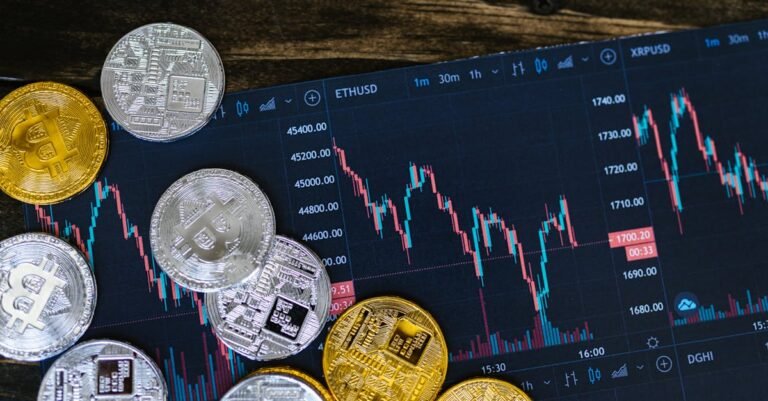Investing for Tomorrow: Uncovering the Best Altcoins for Long Term Growth
Hey everyone! Let’s talk about something exciting: the world of cryptocurrencies beyond Bitcoin. You’ve probably heard about Bitcoin, the king of crypto, but there’s a whole universe of other digital coins out there, known as altcoins. While Bitcoin grabs headlines, some of these altcoins hold incredible potential, especially if you’re thinking about long term crypto investing. It feels a bit like searching for hidden gems, doesn’t it? The idea of finding the next big thing early and watching it grow over years is thrilling. But let’s be real, it’s also a landscape filled with ups, downs, and plenty of noise. Sorting through thousands of projects to find the best altcoins for long term investment can feel overwhelming. Where do you even begin? It’s not about chasing quick profits or jumping on the latest hype train. True long term investing in this space is about understanding the technology, believing in the vision, and having the patience to ride out the inevitable bumps in the road. Think of it like planting a tree – you nurture it, give it time, and hope it grows strong and bears fruit years down the line. This article is your friendly guide, aiming to cut through the jargon and explore what makes certain altcoins potentially great choices for the long haul. We’ll look at what to consider, explore some interesting projects, and discuss how to approach building a future focused crypto portfolio. Remember, this isn’t financial advice, but rather a conversation starter to fuel your own research and discovery journey into the fascinating world of potential altcoins.
Understanding Altcoins and Why Long Term Thinking Matters
So, what exactly *are* altcoins? The name itself gives a clue: “alt” as in alternative, and “coin” as in cryptocurrency. Basically, any cryptocurrency that isn’t Bitcoin is considered an altcoin. Simple, right? They emerged after Bitcoin proved that blockchain technology could work for digital money. Developers saw opportunities to improve upon Bitcoin’s design or use blockchain for entirely different purposes. Think of Bitcoin as the blueprint, the Model T Ford of crypto. Altcoins are like all the other car models that came after, offering different features, speeds, efficiencies, or even serving entirely different functions, like trucks or sports cars.
Why would anyone look beyond Bitcoin for long term crypto investments? Several reasons! Firstly, diversification. Putting all your eggs in one basket is rarely a good strategy in any kind of investing. Adding altcoins can spread your risk. Secondly, potential for higher growth. While Bitcoin is more established, its massive size means multi fold increases might be harder to achieve compared to smaller, innovative altcoins that could capture significant market share in their niche. It’s the classic high risk, high reward scenario, though the risk with unproven altcoins is definitely higher. Thirdly, and perhaps most importantly for long term prospects, altcoins often focus on specific use cases or technological advancements that Bitcoin doesn’t. Some are designed for super fast transactions, others power complex applications like decentralized finance (DeFi) or manage digital identity, and many are building the infrastructure for the next evolution of the internet, often called Web3. These unique applications are what could drive their value over years.
Now, let’s talk about “long term.” In the fast paced world of crypto, “long term” can feel different than in traditional markets. We’re not necessarily talking decades (though that’s possible!), but rather a mindset focused on holding investments through market cycles (which can be quite volatile in crypto!) for perhaps 3, 5, or even 10+ years. This means ignoring the daily or weekly price swings and focusing on the project’s underlying fundamentals and progress. It requires patience and conviction. Finding the best altcoins for long term investment isn’t about timing the market perfectly; it’s about identifying projects with enduring value.
So, what fundamentals should you look for when evaluating potential altcoins? Here’s a breakdown:
- Technology and Innovation: What makes this coin’s blockchain technology special? Is it faster, more secure, more scalable, or does it enable something completely new? Does it have a unique consensus mechanism (like Proof of Stake vs. Proof of Work)? Is the tech genuinely innovative, or just a slight tweak on existing ideas? For example, projects working on solving the “blockchain trilemma” (balancing security, scalability, and decentralization) often have strong long term potential. Look for projects with robust, well designed tech.
- Use Case and Problem Solved: What real world problem does this altcoin aim to solve? Is there a genuine need for its solution? Who are the target users? A coin powering a decentralized social media platform, enabling verifiable supply chain tracking, or facilitating cheaper international payments has a clearer path to adoption than a coin with no obvious purpose beyond speculation. The stronger and more relevant the use case, the better the long term prospects. Think about projects enabling smart contracts for automated agreements or powering the growing decentralized finance (DeFi) ecosystem.
- Team and Development Activity: Who is behind the project? Does the team have relevant experience and expertise? Are they transparent about their progress and challenges? Look for active development – check their GitHub repositories (where code is often shared), read their updates, and see if they are consistently building and improving the platform. A dedicated and skilled team is crucial for navigating the complexities of building and growing a crypto project long term. Avoid projects with anonymous or inactive teams.
- Tokenomics (Token Economics): This is super important! It refers to the economics of the coin itself. Key questions include: What is the total supply of the coin? Is it fixed (like Bitcoin) or inflationary? How are new coins created? What is the coin actually *used* for within its ecosystem? Does owning the coin give you voting rights or a share of network fees? Is there strong demand for the coin based on its utility? Good tokenomics ensure that the coin has intrinsic value and potentially becomes more scarce or in demand over time, supporting its price long term. Poor tokenomics can lead to constant selling pressure or lack of incentive to hold.
- Community and Adoption: Does the project have a strong, active, and supportive community? A vibrant community often indicates genuine interest and belief in the project’s future. Look at their social media channels, forums (like Reddit or Discord), and see if people are actively discussing development, usage, and governance. Furthermore, is the project gaining real world adoption? Are businesses using its technology? Are there partnerships being formed? Growing adoption is a key indicator of long term viability.
- Market Position and Competition: How does this altcoin stack up against its competitors? What is its unique selling proposition? Is the market it’s targeting large enough? While being early is good, understanding the competitive landscape helps assess if the project has a sustainable advantage. Some niches are crowded, so a project needs a clear edge to succeed long term. Considering undervalued altcoins relative to their potential and competitors can be part of this analysis.
Whew, that’s a lot to consider, right? But putting in this groundwork – doing your own research (DYOR) – is absolutely essential for crypto investing, especially with a long term focus. Don’t rely solely on hype or what influencers are pushing. Dig into the whitepapers (though they can be technical, try reading summaries or explanations), understand the core value proposition, and assess the risks. Investing in altcoins carries significant risk; many projects fail. By focusing on these fundamental factors, you can significantly improve your chances of picking projects with real staying power and identifying potentially great long term crypto assets. It’s about making informed decisions based on potential, not just price charts.
Exploring Potential Long Term Altcoin Champions
Alright, let’s dive into some specific examples. Remember, this is not financial advice, and the crypto market is incredibly dynamic – things can change fast! These are examples based on their current technology, adoption, and potential as widely discussed within the crypto community for long term holds. Always do your own thorough research before considering any investment. Our goal here is to illustrate *how* you might analyze potential long term crypto investments using the factors we just discussed.
Ethereum (ETH): The Smart Contract Powerhouse
You can’t really talk about altcoins without talking about Ethereum. While it’s the second largest crypto by market cap, it’s fundamentally different from Bitcoin. Think of Bitcoin as digital gold – a store of value. Ethereum is more like a decentralized world computer or operating system.
- Technology and Innovation: Ethereum introduced the concept of smart contracts – self executing contracts with the terms of the agreement directly written into code. This innovation unlocked a massive range of possibilities. Ethereum is currently undergoing a major upgrade (formerly known as Ethereum 2.0), transitioning from Proof of Work (like Bitcoin) to a more energy efficient and scalable Proof of Stake consensus mechanism. This upgrade aims to address its main challenges: high transaction fees (gas fees) and network congestion. Furthermore, a vibrant ecosystem of Layer 2 scaling solutions (like Polygon, Arbitrum, Optimism) is being built on top of Ethereum to help it process transactions faster and cheaper.
- Use Case and Problem Solved: Ethereum is the bedrock for much of the crypto world’s innovation. Its primary use case is powering decentralized applications (dApps). This includes:
- Decentralized Finance (DeFi): Platforms for lending, borrowing, trading, and earning interest without traditional banks. Think Uniswap, Aave, MakerDAO – many run on Ethereum.
- Non Fungible Tokens (NFTs): Unique digital assets representing ownership of art, collectibles, virtual land, and more. Major NFT marketplaces like OpenSea heavily rely on Ethereum.
- Decentralized Autonomous Organizations (DAOs): Community led organizations governed by code and member votes.
- It’s also becoming foundational for many Web3 cryptos and metaverse projects.
The problem Ethereum solves is the need for a trustworthy, decentralized platform where complex applications can run without censorship or control by a single entity.
- Team and Development Activity: Ethereum has one of the largest and most active developer communities in the crypto space. Co founder Vitalik Buterin remains a key figure, but development is highly decentralized with numerous teams working on the core protocol and related projects. Development progress is transparent, with regular updates and public discussions. The ongoing successful execution of the Proof of Stake merge demonstrates the team’s capability.
- Tokenomics (ETH): ETH is the native currency of the Ethereum network. It’s used to pay transaction fees (gas), securing the network through staking (in the Proof of Stake model), and as collateral in many DeFi applications. The upgrade to Proof of Stake, combined with a mechanism introduced in EIP 1559 that burns a portion of transaction fees, has the potential to make ETH a deflationary asset (meaning supply could decrease over time) if network activity is high enough. This potential scarcity is a strong argument for its long term value.
- Community and Adoption: Ethereum boasts a massive and deeply engaged community of developers, users, and investors. Its network effect is significant – the more projects and users build on Ethereum, the more valuable the network becomes, attracting even more users and developers. Major corporations and financial institutions are also increasingly exploring or building on Ethereum.
- Market Position and Competition: Ethereum is the clear leader in the smart contract platform space. However, it faces stiff competition from newer blockchains (often called “ETH Killers” like Solana, Cardano, Avalanche) that claim to offer higher speeds and lower fees. Its main challenge is successfully scaling to meet demand while maintaining decentralization and security. Yet, its first mover advantage and established ecosystem provide a strong defense.
For investors looking at long term crypto potential, Ethereum represents a bet on the continued growth of DeFi, NFTs, DAOs, and the broader Web3 ecosystem. Its ongoing upgrades and dominant network effect make it a cornerstone consideration for many diversified crypto portfolios, positioning it as one of the most discussed potential altcoins for sustained relevance.
Cardano (ADA): The Research Driven Challenger
Cardano takes a different approach compared to Ethereum’s “build fast and iterate” philosophy. It emphasizes a research driven, peer reviewed methodology, aiming to build a highly secure, scalable, and sustainable blockchain from the ground up.
- Technology and Innovation: Cardano uses a unique Proof of Stake consensus protocol called Ouroboros. Development is methodical, focusing on academic rigor and formal verification (using mathematical methods to prove code correctness). Its architecture is layered (a settlement layer for transactions and a computation layer for smart contracts) which is designed for future flexibility and upgrades. Key focuses include scalability, interoperability (connecting with other blockchains), and sustainability.
- Use Case and Problem Solved: Cardano aims to provide a more balanced and sustainable ecosystem for dApps and financial services. It targets areas where trust and security are paramount, such as:
- Financial services in developing nations (identity solutions, microfinance).
- Verifiable credentials for education and identity management.
- Secure and transparent supply chain tracking.
- Complex DeFi applications requiring high security guarantees.
It seeks to solve the scalability and governance challenges faced by earlier blockchains through meticulous design. The introduction of smart contracts via the Alonzo hard fork enabled DeFi and NFT capabilities on the network.
- Team and Development Activity: Cardano’s development is led by Input Output Global (IOG, formerly IOHK), founded by Ethereum co founder Charles Hoskinson. Development follows a structured roadmap with distinct phases (Byron, Shelley, Goguen, Basho, Voltaire). While sometimes criticized for being slow compared to competitors, this pace reflects its emphasis on peer review and rigorous testing. Development activity is consistent and transparently communicated.
- Tokenomics (ADA): ADA is the native token of the Cardano blockchain. It’s used for transaction fees and for staking to secure the network and earn rewards. ADA holders can also participate in governance through Project Catalyst, voting on proposals for ecosystem development and funding. Cardano has a fixed maximum supply of 45 billion ADA, providing predictable scarcity. The staking mechanism encourages long term holding.
- Community and Adoption: Cardano has a very passionate and active global community. Its focus on real world applications, particularly in Africa, has garnered significant interest. Adoption is growing, especially in the NFT space and emerging DeFi ecosystem on Cardano. Partnerships with governments and educational institutions are key parts of its strategy.
- Market Position and Competition: Cardano competes with Ethereum and other smart contract platforms. Its strengths lie in its research foundation, strong community, and focus on sustainability and governance. Its main challenge is catching up to the network effect of more established platforms like Ethereum and proving its ecosystem can attract significant developer activity and user adoption now that smart contracts are live. Its methodical approach could be a long term advantage if it leads to a more robust and secure platform.
Investing in Cardano is often seen as a bet on its rigorous, academic approach leading to a superior long term blockchain solution. It appeals to those looking for potential altcoins with strong theoretical foundations and a focus on solving real world problems, particularly in underserved regions. It’s a key player to watch in the ongoing evolution of blockchain technology.
These deep dives illustrate the kind of analysis needed. We could spend hours on each! Finding the best altcoins for long term investment means going beyond the surface, understanding the nuances, the strengths, and the weaknesses of each project.
Broadening Horizons: More Altcoins and Portfolio Strategy
While Ethereum and Cardano represent major players often discussed for long term crypto portfolios, the altcoin universe is vast and diverse. Exploring beyond the top few can uncover other exciting projects with significant potential, potentially fitting the bill as undervalued altcoins or specializing in crucial niches for the future of blockchain and Web3.
Let’s touch upon a few other categories and examples, keeping our long term lens focused:
- Layer 1 Competitors (Beyond ETH/ADA):
- Solana (SOL): Known for its incredibly high transaction speeds and low costs, achieved through a unique consensus mechanism called Proof of History (PoH) combined with Proof of Stake. Solana has attracted significant development in DeFi and NFTs due to its performance. However, it has faced criticism regarding network outages and questions about its level of decentralization compared to Ethereum. Long term potential hinges on maintaining stability while growing its ecosystem and proving its unique tech is sustainable and secure. It’s a high risk, potentially high reward play focused on raw speed and throughput.
- Avalanche (AVAX): Offers fast transaction finality (meaning transactions are confirmed very quickly) and uses a novel consensus protocol. Its key feature is “subnets,” which allow projects to create their own customized blockchains that connect to the main Avalanche network. This could be huge for scalability and allowing specific applications (like gaming or enterprise solutions) to have their own tailored environment. Long term success depends on the adoption of its subnet technology and growth of its dApp ecosystem.
- Interoperability Solutions: As more blockchains emerge, the ability for them to communicate and share data becomes crucial. Projects focused on interoperability aim to connect these disparate networks.
- Polkadot (DOT): Founded by another Ethereum co founder, Gavin Wood, Polkadot aims to enable different blockchains (called “parachains”) to connect and communicate within a secure, shared ecosystem. Think of it as a blockchain for blockchains. Its success relies on attracting diverse and valuable projects to become parachains and demonstrating seamless cross chain functionality. DOT token holders participate in governance and can bond their tokens to help secure parachain slots.
- Cosmos (ATOM): Similar to Polkadot, Cosmos focuses on creating an “Internet of Blockchains” where independent blockchains can interconnect using its Inter Blockchain Communication (IBC) protocol. Many significant blockchains have been built using the Cosmos SDK. Its vision is slightly different from Polkadot’s shared security model, emphasizing sovereignty for individual chains. ATOM is primarily used for staking to secure the Cosmos Hub and for governance.
These projects are fundamental bets on a multi chain future, a likely scenario for the evolution of blockchain technology.
- Oracle Networks: Smart contracts on blockchains often need access to real world data (like weather information, asset prices, sports results) to execute properly. Oracle networks provide this crucial link between blockchains and the outside world.
- Chainlink (LINK): The dominant leader in the decentralized oracle space. Chainlink provides secure and reliable data feeds to a vast number of DeFi protocols and other dApps across multiple blockchains. Its technology is essential for many smart contracts to function correctly. Its long term value is tied to the overall growth of the smart contract economy and the increasing need for off chain data on chain. LINK is used to pay node operators for providing data.
Oracles are critical infrastructure for the entire Web3 ecosystem, making projects like Chainlink a potentially vital component for long term growth.
- Niche and Emerging Areas: Keep an eye on projects innovating in specific sectors like:
- Decentralized Storage: Filecoin (FIL), Arweave (AR) – offering alternatives to centralized cloud storage like Amazon S3.
- AI and Blockchain: Projects combining artificial intelligence with blockchain for various applications (e.g., decentralized AI marketplaces, data integrity). This area is still nascent but holds immense potential.
- Decentralized Physical Infrastructure Networks (DePIN): Using crypto incentives to build and operate real world infrastructure like wireless networks, sensor networks, or energy grids (e.g., Helium (HNT)).
This isn’t an exhaustive list, but it shows the variety of altcoins out there, each tackling different problems with unique approaches. Finding the best altcoins for long term investment involves understanding these different categories and how they fit into the bigger picture of technological evolution.
Building Your Long Term Altcoin Portfolio
Okay, so you’ve done some research and identified a few potential altcoins you believe in. Now what? Simply buying a bunch isn’t the best strategy. Building a resilient long term portfolio requires thought and discipline.
- Diversification is Key: Don’t put all your funds into one altcoin, no matter how promising it seems. Spread your investment across several different projects, perhaps in different categories (e.g., a major Layer 1, an interoperability solution, an oracle). This helps mitigate risk – if one project underperforms or fails, it doesn’t wipe out your entire portfolio. How many? There’s no magic number, but somewhere between 5 and 15 carefully chosen projects is often suggested for a manageable, diversified portfolio.
- Understand Your Risk Tolerance: Altcoins are generally riskier than Bitcoin, and some altcoins (especially smaller cap ones) are much riskier than others. Only invest money you can afford to lose. Be honest with yourself about how much volatility you can handle psychologically. Long term investing means holding through potentially deep drawdowns.
- Start Small and Dollar Cost Average (DCA): You don’t need to invest a large sum all at once. Consider starting with smaller amounts. Dollar Cost Averaging is a popular strategy where you invest a fixed amount of money at regular intervals (e.g., $50 every week) regardless of the price. This helps average out your purchase price over time and reduces the risk of buying everything at a market top. It’s a disciplined approach well suited for long term crypto investing.
- Focus on Fundamentals, Not Just Price: While price action is exciting, keep track of the project’s development progress, adoption milestones, and community activity. Is the team delivering on its roadmap? Are more people using the platform? These are better indicators of long term health than short term price fluctuations.
- Stay Informed, But Avoid Emotional Decisions: The crypto space evolves rapidly. Keep learning about the projects you’ve invested in and the broader market trends. Follow reliable news sources and project updates. However, try to avoid making impulsive decisions based on fear (panic selling during dips) or greed (FOMO buying during rallies). Stick to your long term plan.
- Secure Your Assets: Learn about crypto wallets and security best practices. For long term holding, consider using hardware wallets (cold storage) rather than leaving your coins on exchanges, as this gives you greater control and security over your assets.
Building a portfolio of the best altcoins for long term investment is an ongoing process. It requires initial research, careful planning, disciplined execution, and continuous learning. It’s less about getting rich quick and more about participating in potentially revolutionary technologies over the coming years.
Embarking on Your Long Term Crypto Journey
So, there you have it – a whirlwind tour through the world of altcoins and what to look for when considering them for long term investment. We’ve seen that altcoins are much more than just Bitcoin alternatives; they represent a diverse ecosystem of innovation, tackling problems from financial inclusion and decentralized computing to connecting blockchains and bridging the gap with real world data. Identifying the best altcoins for long term investment isn’t about finding a secret list, but about developing a process for evaluation.
Key takeaways to remember:
- Focus on Fundamentals: Dive deep into the technology, the use case, the team, the tokenomics, and the community adoption of any project you consider.
- Think Long Term: Embrace a patient mindset. Be prepared for volatility and focus on the project’s development and potential over years, not days or weeks.
- Do Your Own Research (DYOR): Never invest based solely on hype or someone else’s recommendation. Understand what you’re investing in and the associated risks.
- Diversify Wisely: Spread your investments across several promising projects to mitigate risk.
- Stay Secure: Learn how to protect your crypto assets properly.
The journey into crypto investing, especially focusing on potential altcoins for the long haul, is exciting but demands diligence. It’s about backing technologies and teams you believe are building valuable solutions for the future. Whether it’s the smart contract capabilities of Ethereum, the research driven approach of Cardano, the speed of Solana, the interoperability focus of Polkadot or Cosmos, or the essential data services of Chainlink, each project offers a unique proposition.
The world of blockchain technology and Web3 cryptos is still incredibly young. Investing today means participating in the early stages of what could be a significant technological shift. It requires courage, curiosity, and commitment. But for those willing to put in the effort, the potential rewards – not just financial, but also in being part of building a new digital frontier – could be substantial.
Ready to start your own exploration? Begin by researching one or two projects that caught your interest. Read their official documentation, join their online communities (like Discord or Telegram), and see what people are building and discussing. Remember to start small, invest responsibly, and focus on learning. The world of long term crypto investing awaits!
What altcoins are on your long term radar, and why? Share your thoughts and research strategies in the comments below – let’s learn together!









